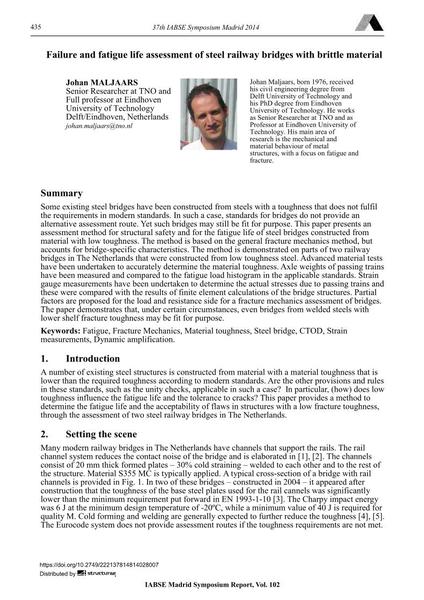Failure and fatigue life assessment of steel railway bridges with brittle material

|
|
|||||||||||
Bibliographic Details
| Author(s): |
Johan Maljaars
|
||||
|---|---|---|---|---|---|
| Medium: | conference paper | ||||
| Language(s): | English | ||||
| Conference: | IABSE Symposium: Engineering for Progress, Nature and People, Madrid, Spain, 3-5 September 2014 | ||||
| Published in: | IABSE Symposium Madrid 2014 | ||||
|
|||||
| Page(s): | 435-442 | ||||
| Total no. of pages: | 8 | ||||
| Year: | 2014 | ||||
| DOI: | 10.2749/222137814814028007 | ||||
| Abstract: |
Some existing steel bridges have been constructed from steels with a toughness that does not fulfil the requirements in modern standards. In such a case, standards for bridges do not provide an alternative assessment route. Yet such bridges may still be fit for purpose. This paper presents an assessment method for structural safety and for the fatigue life of steel bridges constructed from material with low toughness. The method is based on the general fracture mechanics method, but accounts for bridge-specific characteristics. The method is demonstrated on parts of two railway bridges in The Netherlands that were constructed from low toughness steel. Advanced material tests have been undertaken to accurately determine the material toughness. Axle weights of passing trains have been measured and compared to the fatigue load histogram in the applicable standards. Strain gauge measurements have been undertaken to determine the actual stresses due to passing trains and these were compared with the results of finite element calculations of the bridge structures. Partial factors are proposed for the load and resistance side for a fracture mechanics assessment of bridges. The paper demonstrates that, under certain circumstances, even bridges from welded steels with lower shelf fracture toughness may be fit for purpose. |
||||
| Keywords: |
fatigue steel bridge fracture mechanics material toughness strain measurements CTOD Dynamic amplification
|
||||
